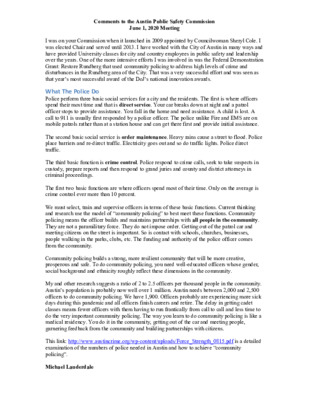Citizen- Mike Lauderdale's comments on #3 APD Cadet Classes — original pdf
Backup

Comments to the Austin Public Safety Commission June 1, 2020 Meeting I was on your Commission when it launched in 2009 appointed by Councilwoman Sheryl Cole. I was elected Chair and served until 2013. I have worked with the City of Austin in many ways and have provided University classes for city and country employees in public safety and leadership over the years. One of the more intensive efforts I was involved in was the Federal Demonstration Grant: Restore Rundberg that used community policing to address high levels of crime and disturbances in the Rundberg area of the City. That was a very successful effort and was seen as that year’s most successful award of the DoJ’s national innovation awards. What The Police Do Police perform three basic social services for a city and the residents. The first is where officers spend their most time and that is direct service. Your car breaks down at night and a patrol officer stops to provide assistance. You fall in the home and need assistance. A child is lost. A call to 911 is usually first responded by a police officer. The police unlike Fire and EMS are on mobile patrols rather than at a station house and can get there first and provide initial assistance. The second basic social service is order maintenance. Heavy rains cause a street to flood. Police place barriers and re-direct traffic. Electricity goes out and so do traffic lights. Police direct traffic. The third basic function is crime control. Police respond to crime calls, seek to take suspects in custody, prepare reports and then respond to grand juries and county and district attorneys in criminal proceedings. The first two basic functions are where officers spend most of their time. Only on the average is crime control ever more than 10 percent. We must select, train and supervise officers in terms of these basic functions. Current thinking and research use the model of “community policing” to best meet these functions. Community policing means the officer builds and maintains partnerships with all people in the community. They are not a paramilitary force. They do not impose order. Getting out of the patrol car and meeting citizens on the street is important. So is contact with schools, churches, businesses, people walking in the parks, clubs, etc. The funding and authority of the police officer comes from the community. Community policing builds a strong, more resilient community that will be more creative, prosperous and safe. To do community policing, you need well-educated officers whose gender, social background and ethnicity roughly reflect these dimensions in the community. My and other research suggests a ratio of 2 to 2.5 officers per thousand people in the community. Austin’s population is probably now well over 1 million. Austin needs between 2,000 and 2,500 officers to do community policing. We have 1,900. Officers probably are experiencing more sick days during this pandemic and all officers finish careers and retire. The delay in getting cadet classes means fewer officers with them having to run frantically from call to call and less time to do the very important community policing. The way you learn to do community policing is like a medical residency. You do it in the community, getting out of the car and meeting people, garnering feedback from the community and building partnerships with citizens. This link: http://www.austincrime.org/wp-content/uploads/Force_Strength_0815.pdf is a detailed examination of the numbers of police needed in Austin and how to achieve “community policing”. Michael Lauderdale 4510 Spanish Oak Trail Austin, Texas